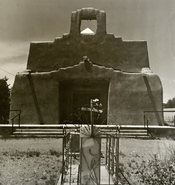He very briefly calculated the exposure to obtain the exposure for the correct textural value of the moon. But the light was rapidly changing and he didn't have time to read other important values, especially in the foreground, so he basically winged it, guessing the rest, and assigned it water bath development trying to salvage something down there in the foreground shadows. Hypothetical bracketing wouldn't have do a damn thing better unless the whole exposure sequence were digitally overlapped and then smashed together and re-tweaked - Thank goodness that lazy default option wasn't invented yet, or there never would have been a masterpiece to discuss. A correctly bracketed shot for the foreground would have blown out the moon, and shouldered it off the curve into blank white. As it is, hard to say whether he did any of the exposure ideally. It was obviously a very difficult shot to print, and he eventually resorted to intensifying the neg.
Lots of people know how to get a correct exposure of a full moon just through prior experimentation with this or that particular film. No miracle there. But it is an interesting anecdote, possibly needing to be taken with a grain of salt.
About a decade ago I bagged a very similarly lit shot, likewise in a rush pulling off the highway with no time to spare. Didn't even have time to fiddle with the view camera, so I took it with my P67 on tripod, using Acros. No problem with the scene contrast range : everything from full moon texture to shimmering clouds, all the way down into deep rich shadows. Just a couple quick reads with the spotmeter, and understanding my film well. Today we have amenities Ansel didn't, including some marvelous VC papers. One correct shot; no need to bracket. No hell printing it like AA had to contend with. Yeah, I would have liked to have used a bigger format myself, and if the lighting had stayed constant I could have. But several seconds off, plus or minus, and the scene simply wouldn't have been there.










